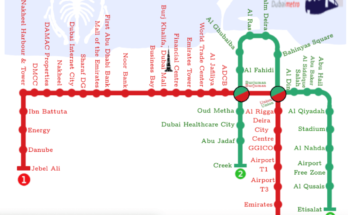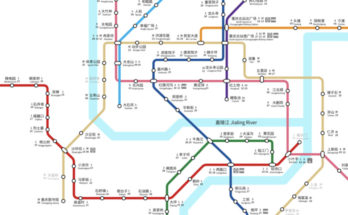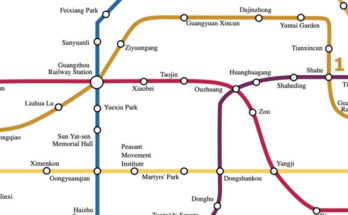Kaohsiung Mass Rapid Transit (KMRT) is the underground metro system serving Kaohsiung, Taiwan’s biggest metropolitan area. Kaohsiung Rapid Transit Corporation (KRTC) manage the 2 open lines, 37 stations and 42.7 km long track. Every day, around 180,000 people travel through this metro system.
With Kaohsiung MRT, it is now possible to reach city’s main business districts and tourist attractions within minutes. The subway stations are uniquely decorated. Central Park Station and Formosa Boulevard Station have received much international level recognition for their architectural beauties and inside artworks.
Historical Background
Kaohsiung is an important commercial hub and international port. Taiwan’s biggest industrial zones are located within the city. In the past few decades, there has been a massive spurt in the population of the city causing alarming road traffic pressure.
Since 1987, the city government was planning for an alternative rapid transit system. In 1990, the funding approval came from the central government. Total 11 main lines and 6 extensions were planned for KMRT system. However, many issues stalled the progress of the project. Finally, in 2000, KRTC was given the Build-Operate-Transfer contract to build the first 2 main lines.
Construction started in October 2001 and in November 2006, test run began for Red Line. After surviving really hard times, KRTC finally initiated the full operation of the Red Line in a phase wise manner in 2008. Gangshan South station was connected on December 23, 2012. The Orange Line started operating from September 14, 2008.
Hours of Operation
The Red Line operates from 6:00 AM to around 12:30 AM. Trains on Orange Line stop running at 11:30 PM. One train comes every 8 minutes, in the peak hours every 4 to 6 minutes. After 23:00 PM, trains run every 20 minutes.
Lines and Stations
The Kaohsiung Metro system currently has only two operating lines, Red Line and Orange Line. At Formosa Boulevard Station, the Orange and the Red Lines cross each other.
Red Line
The line starts from Siaogang in the south and finally connects to Gangshan South in the northern corner of the Kaohsiung metro area. It runs through important locations in the city, like Kaohsiung International Airport, Central Park, Nanzih Export Processing Zone etc. There are 24 stations on this route, of which 15 are underground, 1 is at the ground level and 8 are elevated. The whole route is 28.3 km long. To travel on the complete route, it takes around 40 minutes.
Transfer to TRA West Coast Main Line and to Orange Line is possible from this route. When other lines of Kaohsiung Metro system will be operational, more interchanging possibilities will open from Red Line.
Main stations on this line are:
- Siaogang
- Kaohsiung International Airport
- Cianjhen Senior High School
- Shihjia
- Sanduo Shopping District
- Central Park
- Formosa Boulevard
- Kaohsiung Main Station
- Kaohsiung Arena
- Ecological District
- World Games/ National Sports Complex
- Nanzih Export Processing Zone
- Metropolitan Park
- Ciaotou Station
- Gangshan South
Orange Line
The orange line connects 14 stations on a 14.4 km long east-west route. Starting from Sizihwan station in the west it runs through the center part of the city and ends at Daliao station in the east. It takes less than half an hour to complete the whole journey.
All of the stations on this line are underground except Daliao. Interchange is possible to Red Line and to TRA West Coast Main Line at different stations. If the complete network works, transfer is going to improve on this line also.
Main stations on this line are:
- Sizihwan
- City Council
- Formosa Boulevard
- Cultural Center
- Martial Arts Stadium
- Weiwuying
- Fongshan
- Fongshan Junior High School
- Daliao
Light Rail
A circular Light Rail Line is being constructed to serve the central part of the city. It will connect 36 stations and will have a 22.1 km long route intersecting both Red and Orange lines.
Phase I of construction work began in 2013 and it is expected to start commuting passengers from the mid of 2016. The line begins from Lizihnei, connects major shopping areas, business districts, educational institutes, museums, a stadium and ends at Hamaxing.
Future Expansion
KMRT will be further extended to cover parts of Kaohsiung County and Pingtung County. Current operational lines will be further extended and other planned lines will start operating soon.
The Red Line is planned to be extended in the north to Hunei District and in the south to Pingtung County. The Orange Line is planned to have a Daliao Extension and a Pingtung Extension. The Circular Line will also be extended to Phase II.
The new lines that are either planned or proposed include Yanchao Line, Youchang Line, Brown Line, Yellow Line, Fongshan Line, Green Line and Foguangshan Line. One line and one extension from the original plan were terminated.
Fare and Tickets
The fare for KMRT is calculated on the basis of distance. The minimum fare is NT$ 20 for a travel within 10 km. The maximum fare is NT$ 60. Ticket prices vary depending on the age of the traveler. For a group of 10 or more people, there is a discount of 20% on the total regular ticket fare.
Three types of tickets are available: RFID IC token, I-Pass and smart card. However, similar smart cards of Taipei and Taichung services can not be used in KMRT. All types of tickets are scanned at entry and exit points.
For bikers traveling with non-folding bikes, there is a special ticket which costs NT$ 100. KRTC also issues multiple day pass tickets to I-Pass eligible riders. These tickets are issued for a day or two to make unlimited journeys with KMRT. These special tickets are available only by passenger information counters. Single journey tokens can be purchased either from passenger information counters or from automatic ticket vending machines.
Details of KRTC ticket types and prices are to be found on the Ticket Information page.
Facilities and Services
KRTC is not happy with the daily ridership data and is continually trying to improve it. It has designed some useful services for the passengers.
- Platforms and trains are wheelchair-friendly.
- Platform screen doors are there at all underground stations. These doors are fitted with LCD televisions showing train schedule and other important information.
- All the written information is available in Chinese and English. Announcements are made in Taiwanese, Mandarin, English, Hakka and sometimes in Japanese.
- All the stations have baggage storage locker facility.
Rules
Rules set by KRTC should be strictly followed in order to allow smooth service and also to avoid paying fines.
- Eating, drinking, chewing gums, smoking etc. are strictly prohibited within the station paid area.
- Passengers can not stay for more than 2 hours in the arrival and departure stations.
- Passengers are not allowed to carry objects with them that are more than 165 cm long and are more than 220 cm, summing the length, height and width.
Tips
Here are the tips to get the best out of the KMRT service:
- There is always a place for one passenger to lie between the platform and the track. Don’t fright if you fall on the track and the train is near.
- Make use of the Nighttime Waiting Zones located at every station if you are a lady and are traveling late at night.
- Every KMRT station has a nearby bus route. Plan the journey accordingly to save time.



